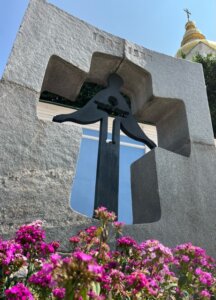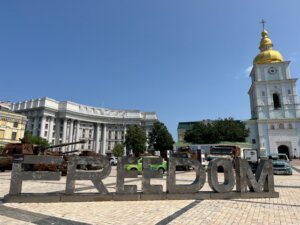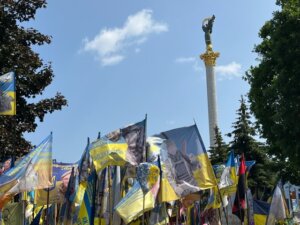
Holodomor
We’ve been doing as much talking as working in the garden here in Kyiv, because Ukrainians, as with many Europeans are bilingual, at minimum. And they love to chat. So we visit with all sorts of people, some eager to keep their history alive by telling their stories.
I’m embarrassed to admit that I didn’t know about the famine of 1932-1933, known here as the Holodomor. Holodomor was a preplanned siege by the Soviet Union to repress efforts by Ukrainian farmers to remain independent from the USSR.
A woman told me this story in the garden. I had to go look it up. What I found on the website of the Holodomor Museum filled in more details.
The history of the oppression of the Ukrainian people goes back to the late 1700’s, when the entire left bank of the Dniper River was colonized by the Muscovites as Little Russia. Ukrainian language and culture was suppressed or banned and Ukraine was Russified.
The Ukrainian People’s Republic was established in 1918. By 1922, Ukraine was incorporated into the USSR, with the agreement that all republics were equal.
The spirit of independence however, remained strong in Ukraine and became problematic for the communists. Anyone resisting the collectivization of small farms in 1928 was targeted. Protests became frequent and the communist rulers used terror and propaganda to try to control the farmers who spoke out against the poor conditions and long hours forced on them in the collectives. According to the Holodomor Museum website, over 4000 mass demonstrations occurred protesting collectivization, taxes, robbery, terror and violence in the early 1930’s.
To subdue Ukraine, Stalin forced a famine by implementing a grain procurement plan with impossible production requirements. When farmers failed to meet production, all the grain and other food stocks were seized, creating a famine. Further crackdowns occurred through blockades of any incoming foods, including aid from the International Red Cross.
In January 1933, Stalin signed an order restricting travel of anyone from the famine ravaged area. The famine was at its peak by June 1933, when 28,000 people were dying every day.
One result of the genocide was that large farms in the east part of Ukraine became available to resettlement by Russians. So when confused people incorrectly say that Ukraine is half Russian, they may not be aware of the full history.
Russian propaganda has continued to assert that the famine was non-existent, and the use of “hunger” as the cause of death of death records was banned. How many died in the famine of 1932-1933 will never be known, but it is estimated in the millions; all while the Soviet regime sat on stockpiles of grain.
So, the reason I never heard of this before is that the Russian propaganda machine was as strong as the Nazi propaganda machine. But the Ukrainians still have their history, their family members who died, and they will continue to tell their story.
The Holodomor Museum offers a media literacy class to high school age students in order to learn how to identify propaganda.
In this war, the Ukrainians will never break. They will not acquiesce. Putin wants territory. Ukrainians are fighting for their lives. You may recall that just before the full scale invasion, Russian soldiers were told they were going into Ukraine to rescue them from a Nazi takeover. They found out that wasn’t true and they’d been lied to. Many lost their lives over a lie.
When you hear people try to justify this invasion of a sovereign nation by suggesting the left bank and eastward is culturally Russian, you can correctly remind them that the Ukrainians living of that land were exterminated and replaced by Russians.


Additional details for this history are from Ukraïner.net.
